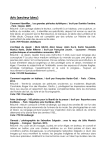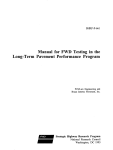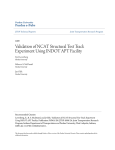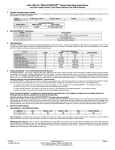Download Improving the Accuracy and Usability of Iowa Falling Weight
Transcript
Improving the Accuracy
and Usability of Iowa
Falling Weight
Deflectometer Data
Final Report
May 2013
Sponsored by
Iowa Department of Transportation
Federal Highway Administration
(InTrans Project 11-419)
About the Institute for Transportation
The mission of the Institute for Transportation (InTrans) at Iowa State University is to develop
and implement innovative methods, materials, and technologies for improving transportation
efficiency, safety, reliability, and sustainability while improving the learning environment of
students, faculty, and staff in transportation-related fields.
Disclaimer Notice
The contents of this report reflect the views of the authors, who are responsible for the facts
and the accuracy of the information presented herein. The opinions, findings and conclusions
expressed in this publication are those of the authors and not necessarily those of the sponsors.
The sponsors assume no liability for the contents or use of the information contained in this
document. This report does not constitute a standard, specification, or regulation.
The sponsors do not endorse products or manufacturers. Trademarks or manufacturers’ names
appear in this report only because they are considered essential to the objective of the document.
Non-Discrimination Statement
Iowa State University does not discriminate on the basis of race, color, age, religion, national
origin, sexual orientation, gender identity, genetic information, sex, marital status, disability,
or status as a U.S. veteran. Inquiries can be directed to the Director of Equal Opportunity and
Compliance, 3280 Beardshear Hall, (515) 294-7612.
Iowa Department of Transportation Statements
Federal and state laws prohibit employment and/or public accommodation discrimination on
the basis of age, color, creed, disability, gender identity, national origin, pregnancy, race, religion,
sex, sexual orientation or veteran’s status. If you believe you have been discriminated against,
please contact the Iowa Civil Rights Commission at 800-457-4416 or the Iowa Department of
Transportation affirmative action officer. If you need accommodations because of a disability to
access the Iowa Department of Transportation’s services, contact the agency’s affirmative action
officer at 800-262-0003.
The preparation of this report was financed in part through funds provided by the Iowa
Department of Transportation through its “Second Revised Agreement for the Management of
Research Conducted by Iowa State University for the Iowa Department of Transportation” and
its amendments.
The opinions, findings, and conclusions expressed in this publication are those of the authors
and not necessarily those of the Iowa Department of Transportation or the U.S. Department of
Transportation.
Technical Report Documentation Page
1. Report No.
InTrans Project 11-415
2. Government Accession No.
4. Title and Subtitle
Improving the Accuracy and Usability of Iowa Falling Weight Deflectometer Data
3. Recipient’s Catalog No.
5. Report Date
May 2013
6. Performing Organization Code
7. Author(s)
Halil Ceylan, Kasthurirangan Gopalakrishnan, and Sunghwan Kim
8. Performing Organization Report No.
InTrans Project 11-415
9. Performing Organization Name and Address
Institute for Transportation
Iowa State University
2711 South Loop Drive, Suite 4700
Ames, IA 50010-8664
10. Work Unit No. (TRAIS)
12. Sponsoring Organization Name and Address
Iowa Department of Transportation
Federal Highway Administration
800 Lincoln Way
U.S. Department of Transportation
Ames, IA 50010
1200 New Jersey Avenue SE
Washington, DC 20590
13. Type of Report and Period Covered
Final Report
11. Contract or Grant No.
14. Sponsoring Agency Code
SPR 90-00-RB04-012
15. Supplementary Notes
Visit www.intrans.iastate.edu for color PDF files of this and other research reports.
16. Abstract
This study aims to improve the accuracy and usability of Iowa Falling Weight Deflectometer (FWD) data by incorporating significant
enhancements into the fully-automated software system for rapid processing of the FWD data. These enhancements include: (1) refined
prediction of backcalculated pavement layer modulus through deflection basin matching/optimization, (2) temperature correction of
backcalculated Hot-Mix Asphalt (HMA) layer modulus, (3) computation of 1993 AASHTO design guide related effective SN (SNeff)
and effective k-value (keff ), (4) computation of Iowa DOT asphalt concrete (AC) overlay design related Structural Rating (SR) and kvalue (k), and (5) enhancement of user-friendliness of input and output from the software tool. A high-quality, easy-to-use
backcalculation software package, referred to as, I-BACK: the Iowa Pavement Backcalculation Software, was developed to achieve the
project goals and requirements. This report presents theoretical background behind the incorporated enhancements as well as guidance
on the use of I-BACK developed in this study. The developed tool, I-BACK, provides more fine-tuned ANN pavement backcalculation
results by implementation of deflection basin matching optimizer for conventional flexible, full-depth, rigid, and composite pavements.
Implementation of this tool within Iowa DOT will facilitate accurate pavement structural evaluation and rehabilitation designs for
pavement/asset management purposes. This research has also set the framework for the development of a simplified FWD deflection
based HMA overlay design procedure which is one of the recommended areas for future research.
17. Key Words
analysis tool—asset management—FWD—HMA—pavement—PCC
18. Distribution Statement
No restrictions.
19. Security Classification (of this
report)
Unclassified.
21. No. of Pages
22. Price
48
NA
Form DOT F 1700.7 (8-72)
20. Security Classification (of this
page)
Unclassified.
Reproduction of completed page authorized
IMPROVING THE ACCURACY AND USABILITY
OF IOWA FALLING WEIGHT DEFLECTOMETER
DATA
Final Report
May 2013
Principal Investigator
Halil Ceylan, Associate Professor
Institute for Transportation, Iowa State University
Co-Principal Investigators
Kasthurirangan Gopalakrishnan, Research Assistant Professor
Institute for Transportation, Iowa State University
Sunghwan Kim, Research Assistant Professor
Institute for Transportation, Iowa State University
Authors
Halil Ceylan, Kasthurirangan Gopalakrishnan, and Sunghwan Kim
Sponsored by
Iowa Department of Transportation
Federal Highway Administration
(SPR 90-00-RB04-012)
Preparation of this report was financed in part
through funds provided by the Iowa Department of Transportation
through its Research Management Agreement with the
Institute for Transportation
(InTrans Project 11-415)
A report from
Institute for Transportation
Iowa State University
2711 South Loop Drive, Suite 4700
Ames, IA 50010-8664
Phone: 515-294-8103
Fax: 515-294-0467
www.intrans.iastate.edu
TABLE OF CONTENTS
ACKNOWLEDGMENTS ............................................................................................................. ix
EXECUTIVE SUMMARY ........................................................................................................... xi
INTRODUCTION ...........................................................................................................................1
Background ..........................................................................................................................1
Objective and Scope ............................................................................................................2
I-BACK: ENHANCEMENT FEATURES AND MODULES ........................................................2
Deflection Basin Matching ..................................................................................................3
Temperature Normalization for HMA Modulus ..................................................................5
Computation of Effective Structural Number (SN) and Subgrade Support (k-value):
AASHTO Pre ME-Design Approach...................................................................................7
Computation of Structural Rating (SR) and Soil Support (k-value): Iowa DOT AC
Overlay Design Procedure Using Road Rater Deflection Measurements ...........................8
I-BACK USER MANUAL ............................................................................................................17
Program Main Menus ........................................................................................................17
Pavement Analysis Menus .................................................................................................19
Summary Result File..........................................................................................................32
SUMMARY ...................................................................................................................................33
REFERENCES ..............................................................................................................................35
v
LIST OF FIGURES
Figure 1. I-BACK analysis flow chart for flexible pavement ..........................................................3
Figure 2. I-BACK analysis flow chart for rigid pavement ..............................................................4
Figure 3. I-BACK analysis flow chart for composite pavement (HMA overlaid PCC pavement) .5
Figure 4. Generalized linear correlation equation with coefficients between FWD and Road Rater
deflection measurements; Note. senor 1 deflection (d0), sensor 2 deflection (d12), sensor 3
deflection (d24), and sensor 4 deflection (d36) (adapted from Jones and Hanson 1991) ......9
Figure 5. Flexible pavement base relationship between SR and Road Rater D0 at 80F (adapted
from Potter and Dirks 1989) ..............................................................................................10
Figure 6. Flexible pavement SR determination nomograph (adapted from Potter and Dirks 1989)10
Figure 7. Road Rater D0 temperature correction for flexible pavement: nomograph versus
equation ..............................................................................................................................11
Figure 8. SR determination for flexible pavement: nomograph versus equation ..........................12
Figure 9. Rigid and composite pavement base relationship between SR and Road Rater D0
(adapted from Potter and Dirks 1989) ...............................................................................13
Figure 10. SR determination for rigid and composite pavements: chart versus equation .............13
Figure 11. Flexible pavement base relationship for soil support k-value determination (adapted
from Potter and Dirks 1989) ..............................................................................................15
Figure 12. Rigid and composite pavement base relationship for soil support k-value
determination (adapted from Potter and Dirks 1989) ........................................................15
Figure 13. k-value determination for flexible pavement: chart versus equation ...........................16
Figure 14. k-value determination for rigid and composite pavements: chart versus equation ......16
Figure 15. I-BACK program main menu .......................................................................................18
Figure 16. ANN Information: (a) ANN Information button in main menu, (b) Screenshot of main
menu on choosing ANN info show option, (c) Sample Excel sheet for ANN model
information .........................................................................................................................19
Figure 17. I-BACK pavement analyses menu for conventional flexible pavement analysis ........20
Figure 18. General information window ........................................................................................22
Figure 19. Screen shot of effective PCC thickness equations sheet ..............................................23
Figure 20. Screen shot of FWD data extraction through open FWD data file button ...................24
Figure 21. Filtering the FWD data: (a) Filter options menu, (b) Filtering results (no filtered data
in this example) ..................................................................................................................25
Figure 22. ANN based preliminary backcalculation analysis: (a) Preliminary backcalculation
analysis result outputs, (b) Progress report window after completing ANN based
preliminary backcalculation analysis .................................................................................26
Figure 23. Deflection basin matching/optimization of backcalculation analysis: (a) Optimized
backcalculation analysis result outputs, (b) Trial solution check message box .................27
Figure 24. Progress report window after completing optimization of backcalculation analysis: (a)
flexible and composite pavements, (b) rigid pavement .....................................................28
Figure 25. HMA modulus temperature correction: (a) Temperature corrected HMA modulus
result outputs, (b) Progress report window after completing HMA modulus temperature
correction ...........................................................................................................................29
Figure 26. Effective k-value (keff ) for rigid and composite pavements ........................................30
Figure 27. Effective SN (SNeff) with effective modulus of pavement layer (Ep) for flexible
pavement ............................................................................................................................31
vii
Figure 28. Road Rater Based SR and k for flexible pavement ......................................................32
Figure 29. Final Progress report window after completion of analysis .........................................32
LIST OF TABLES
Table 1. Key required inputs and outputs produced by I-BACK ..................................................21
viii
ACKNOWLEDGMENTS
The authors would like to thank the Iowa Department of Transportation (DOT) for sponsoring
this research and the Federal Highway Administration for state planning and research (SPR)
funds used for this project.
The project technical advisory committee (TAC) members from the Iowa DOT, including Jason
Omundson, Chris Brakke, Fereidoon (Ben) Behnami, Kevin Jones, Scott Schram, Todd Hanson,
and Tom Muhlenbruch are gratefully acknowledged for their guidance, support, and direction
throughout the research.
ix
EXECUTIVE SUMMARY
Highway agencies periodically evaluate the structural condition of roads as part of their routine
maintenance and rehabilitation activities. The falling-weight deflectometer (FWD) test measures
road surface deflections resulting from an applied impulse loading, simulative of a truck passing
on the highway. The measured surface deflections are utilized to determine pavement layer
stiffnesses through a backcalculation type structural analysis.
Although the Iowa Department of Transportation (DOT) has been collecting the FWD data on a
regular basis, the pavement layer moduli backcalculation techniques used so far have been
cumbersome and time consuming. More efficient and faster methods in FWD test data analysis
were deemed necessary for routine analysis.
Previous Iowa DOT research projects focused on developing advanced pavement layer moduli
backcalculation models using the artificial neural networks (ANN) methodology. The developed
models were successfully validated using field data and incorporated into a Microsoft Excel
spreadsheet-based backcalculation software toolbox with a user-friendly interface.
This study was undertaken with the objectives of improving the accuracy and usability of Iowa
FWD data and the pavement inverse analysis tools. Based on the requirements by the technical
advisory committee (TAC) members representing potential users of the developed
backcalculation software system at the Iowa DOT, significant enhancements were incorporated
into the fully-automated software system for rapid processing of the FWD data.
These enhancements include the following:
Refined prediction of pavement layer modulus through deflection basin
matching/optimization
Temperature correction of HMA layer modulus
Computation of 1993 AASHTO design guide-based effective structural number (SNeff)
and effective k-value (keff)
Computation of Iowa DOT asphalt concrete (AC) overlay design-based structural rating
(SR) and k-value (k)
Enhancement of user-friendliness of input and output from the software tool
A high-quality, easy-to-use, backcalculation software package called Iowa Pavement
Backcalculation (I-BACK) software was developed to achieve the project goals and yielded the
following highlighted benefits:
Provides more-fine-tuned ANN pavement backcalculation results by implementation of
deflection matching optimizer for conventional flexible, full-depth, rigid, and composite
pavements
Provides temperature normalized/corrected hot-mix asphalt (HMA) layer modulus at a
standard reference temperature for conventional flexible, full-depth and composite
pavements
Provides effective SNeff and the effective k-value (keff ) as final outputs for
pavement/asset management purposes
Provides SR and k-value (k) as final outputs to make FWD deflection measurements
suitable for use in the existing Iowa DOT AC overlay design procedure
Produces separate smaller-sized output files from backcalculation analysis
Produce separate smaller sized output files from backcalculation analysis
INTRODUCTION
Background
Evaluating the structural condition of existing, in-service pavements is part of the routine
maintenance and rehabilitation activities undertaken by the most Departments of Transportation
(DOTs). In the field, the pavement deflection profiles (or basins) gathered from the
nondestructive Falling Weight Deflectometer (FWD) test data are typically used to evaluate
pavement structural condition. FWD testing is often preferred over destructive testing methods
because it is faster than destructive tests and does not entail the removal of pavement materials.
This kind of evaluation requires the use of backcalculation type structural analysis to determine
pavement layer stiffnesses and further estimate pavement remaining life. Although the Office of
Special Investigations at Iowa Department of Transportation (DOT) has collected the FWD data
on regular basis, the pavement layer moduli backcalculation techniques used so far have been
cumbersome and time consuming. Thus, there was a need for more efficient and faster methods.
In a previous Iowa DOT project entitled, “Nondestructive Evaluation of Iowa PavementsPhase I,” advanced backcalculation models were developed using the Artificial Neural Networks
(ANN) methodology (Ceylan et al. 2007). These ANN models are capable of predicting
pavement layer stiffnesses as well as pavement critical responses (forward modeling) fully based
on FWD test results and pavement layer thickness information. For the three pavement types,
over 300 models in total were developed for varying input parameters. The primary pavement
types considered were flexible (conventional and full-depth), rigid, and composite.
Predicted flexible pavement parameters were, EAC-modulus of hot-mix asphalt (HMA) or asphalt
concrete (AC), Kb-base modulus parameter, ERi-subgrade resilient modulus, εAC-tensile strain at
the bottom of asphalt layer, εSG-compressive strain at the top of subgrade, and σD-subgrade
deviator stress. For rigid pavements, EPCC-modulus of portland cement concrete (PCC), kscoefficient of subgrade reaction, σPCC-tensile stress at the bottom of the PCC layer, and radius of
relative stiffness (RRS) were predicted. In the case of composite pavements (CPs), where an
HMA/AC surface is overlaid on top of an existing PCC pavement, EAC, EPCC, ks, σPCC (tensile
stress at the bottom of the PCC), and εAC were predicted.
The developed methodology was successfully verified using results from long-term pavement
performance (LTPP) FWD test results, as well as Iowa DOT FWD field data. All successfully
developed ANN models were incorporated into a Microsoft Excel spreadsheet-based
backcalculation software toolbox with a user-friendly interface. The phase I study also concluded
that the developed nondestructive pavement evaluation methodology for analyzing the FWD
deflection data would be adopted by Iowa DOT pavement and material engineers and
technicians, who do not employ any preferable FWD backcalculation analysis technique.
A follow-up Phase II study of Iowa DOT Project (Ceylan et al. 2009) focused on the
development of a fully-automated software system for rapid processing of the FWD data. The
software system can automatically read the FWD raw data collected by the JILS-20 type FWD
machine that Iowa DOTowns, process and analyze the collected data with the algorithms being
1
developed during the phase I study. This system smoothly integrates the FWD data analysis
algorithms and the computer program being used to collect the pavement deflection data. With
the implementation of the developed software system the FWD data can be filtered, processed
and analyzed on-the-fly.
Objective and Scope
The objective of this study is to incorporate significant enhancements into the developed fullyautomated software system for rapid processing of the FWD data. Based on the requirements by
the Technical Advisory Committee (TAC) members and engineers who will be using the
program on a routine basis, the following enhancements were incorporated into the fullyautomated software system, referred to as I-BACK: the Iowa Pavement Backcalculation
Software:
Deflection basin matching: After predicting the pavement layer modulus based on ANN
models, adjust them to match the input deflection basin
Temperature normalization/correction of HMA layer modulus
Computation of overall pavement section effective Structural Number (SNeff) and
subgrade support (keff) following 1993 AASHTO design guide based procedures
Computation of Structural Rating (SR) and soil support (k) following Iowa DOT Road
Rater based AC Overlay Design Procedure
Enhancement of user-friendliness of input and output from the software
I-BACK: ENHANCEMENT FEATURES AND MODULES
The I-BACK analysis flow charts are depicted in Figure 1 for flexible pavements (conventional
HMA and full depth HMA pavements), Figure 2 for rigid pavements (PCC surface pavements),
and Figure 3 for composite pavements (HMA overlaid PCC pavements).
As a first step in the I-BACK analysis, the pre-final pavement layer moduli are calculated from
ANN backcalculation models (Ceylan et al. 2007, Ceylan eat al. 2009). Then, the pre-final
pavement layer moduli are adjusted through a deflection basin optimizer in I-BACK to match the
actual measured FWD deflection basin. Note that the backcalculated moduli resulting from
deflection basin optimization in I-BACK are moduli at pavement temperature at the time of
FWD testing.
In the case of flexible pavement analysis, the temperature normalization routine is then invoked
to correct the adjusted HMA moduli from optimizer to a standard reference temperature.
The SNeff values are computed for conventional flexible and full-depth pavements in accordance
with the AASHTO design procedure as follows. The temperature normalized HMA moduli are
inputted into ANN forward models to produce FWD deflection basin at a standard reference
temperature. The predicted FWD deflection basin at the standard reference temperature is then
2
utilized to compute the overall section SNeff for flexible pavements in accordance with the 1993
AASHTO pavement design procedure (AASHTO 1993).
For rigid pavement analysis, the adjusted subgrade stiffness values from the deflection basin
optimizer are utilized to compute effective subgrade support (keff) in accordance with the 1993
AASHTO design procedure (AASHTO 1993).
For composite pavement (HMA overlaid PCC pavements) analysis, the adjusted HMA moduli
from the deflection basin optimizer are corrected to a standard reference temperature through
temperature normalization routine similar to flexible pavement analysis. Similar to rigid
pavement analysis, the adjusted subgrade stiffness values from the deflection basin optimizer are
utilized to compute keff values in accordance with the 1993 AASHTO design procedure
(AASHTO 1993).
The SR and k values are also computed for all three types of pavement in accordance with Iowa
DOT Road Rater based AC overlay design procedure.
Figure 1. I-BACK analysis flow chart for flexible pavement
Deflection Basin Matching
Deflection basin matching provides a fool-proof method to validate the ANN-based
backcalculation results since the predicted pavement layer moduli are optimized or fine-tuned to
obtain a very close match between the actual FWD and predicted deflections. The pre finalpavement layer moduli from ANN backcalculation models are inputted into the ANN forward
3
models to predict the deflection basin and compare how closely the predicted deflection basin
matches the measured deflection basin. The differences between the field measured and
predicted deflection basins are minimized by adapting the in-built Excel Solver tool (employing
evolutionary optimization or GRG Nonlinear optimization) in I-BACK. Thus, the robustness of
I-BACK predictions has been greatly improved by incorporating the deflection basin
matching/optimization routine.
Figure 2. I-BACK analysis flow chart for rigid pavement
4
Figure 3. I-BACK analysis flow chart for composite pavement (HMA overlaid PCC
pavement)
Temperature Normalization for HMA Modulus
The stiffness, or modulus, of HMA is very temperature-sensitive. The temperature normalization
routine was incorporated into I-BACK in close consultation with the TAC in order to correct the
backcalculated HMA moduli to a standard reference temperature for the section being analyzed.
The incorporated temperature normalization routine consists of: (1) HMA pavement temperature
estimation and (2) temperature correction algorithm for HMA modulus.
Prediction of HMA Pavement Temperature
Before correction of the backcalculated HMA moduli to a standard reference temperature, the
mid-depth pavement temperature at which FWD deflections were taken should be identified. The
direct measurement of this temperature requires the time-consuming process of installation of
temperature probe in depth of pavement. Alternatively, this temperature may be estimated from
approximate methods based on air and surface temperatures measured at the time of FWD
testing. Lukanen et al. (2000) developed a set of equations called as BELLS models for
predicting in-depth pavement temperatures in LTPP testing based on empirical data. Among
these equations, the BELLS3 model accounts for shaded condition of pavement surface under
routine testing conducted by most highway agencies. The BELLS3 model employed in
temperature normalization routine is expressed as follows:
5
𝑇𝑑 = 0.95 + 0.892 × 𝐼𝑅 + {𝑙𝑜𝑔(𝑑) − 1.25}{−0.448 × 𝐼𝑅 + 0.621 ∗ (1𝑑𝑎𝑦) + 1.83 × 𝑠𝑖𝑛(ℎ𝑟18 −
15.5)} + 0.042 × 𝐼𝑅 × 𝑠𝑖𝑛(ℎ𝑟18 − 13.5)
(1)
Where:
Td = Pavement temperature at depth d in °C
IR = Infrared surface temperature measured at the time of FWD testing in °C
Log = Base 10 logarithm
d = Depth at which mat temperature is to be predicted, mm
1-day = Average air temperature the day before testing
sin = Sine function on an 18-hr clock system, with 2 radians equal to one 18-hr cycle
hr18 = Time of day, in 24-hr clock system, but calculated using an 18-hr asphalt concrete
(AC) temperature rise and fall time cycle
Temperature Correction for HMA Modulus
Several equations (Ullidtz 1987, Baltzer and Jansen 1994, Deacon et al. 1994, Noureldin 1994,
Kim et al. 1995, Ali and Lopez 1996, Lukanen et al. 2000, Chen et al., 2000) have been proposed
relating the HMA modulus to a standard reference temperature. However, different values of
standard reference temperature are found in literature for HMA modulus characterization. The
commonly used standard reference temperatures are 68ºF in AASHTO 1993 design procedure
(AASHTO 1993), 70 ºF in AASHTO Mechanistic-Empirical Pavement Design Guide (MEPDG)
(AASHTO 2008) and Pavement ME (formerly, DARWin-ME) (AASHTO 2012), 77 ºF in some
previous studies (Noureldin 1994). Among them, the temperature correction equation developed
by Chen et al (2000) using Texas Mobile Load Simulator (MLS) data is the only available model
with the flexibility to normalize to any reference temperature with good accuracy. Considering
this advantage, it was incorporated into the temperature normalization routine in I-BACK:
𝐸𝑇𝑤 = 𝐸𝑇𝑐 ⁄[(1.8𝑇𝑊 + 32)2.4462 ∗ (1.8𝑇𝐶 + 32)−2.4462 ]
(2)
Where:
ETw= the adjusted modulus of elasticity at Tw, MPa
ETc = the adjusted modulus of elasticity at Tc, MPa
Tw = the temperature to which the modulus of elasticity is adjusted, ℃
Tc = the mid-depth temperature at the time of FWD data collection, ℃
Although a standard reference temperature of 68ºF is utilized in the current implementation of IBACK, the temperature correction equation proposed by Chen et al. (2000) could be easily
adapted later for any reference temperature, should a need arise.
6
Computation of Effective Structural Number (SN) and Subgrade Support (k-value):
AASHTO Pre ME-Design Approach
The concept of SNeff is typically used for evaluating the overall structural condition of flexible
pavements. Similarly, the keff is used for determining the subgrade support for PCC rigid
pavement and composite pavement analysis. Typically, when the ratio of SNeff to as-built SN
based on in-place pavement structure falls below 90%, the evaluated section is recommended for
structural improvement. The AASHTO 1993 design procedure (AASHTO 1993) outlines a
method for calculation of SNeff and the keff using the measured deflection data. The SNeff and the
keff equations in the AASHTO 1993 design procedure (AASHTO 1993) are expressed as follows:
𝑆𝑁𝑒𝑓𝑓 = 0.0045𝐷 3√𝐸𝑝
(3)
(4)
𝑘𝑒𝑓𝑓 = 𝑘𝑑𝑦𝑛𝑎𝑚𝑖𝑐 /2
Where:
D = total pavement thickness, inch
EP = effective modulus of pavement layers, psi
kdynamic = effective dynamic modulus of pavement layers calculated from deflection basin,
psi
Following the AASHTO 1993 design procedure, the pseudo-codes and algorithms for
implementing the computation of these two parameters (SNeff and keff ) in I-BACK were
developed . First, the deflection basin at the reference temperature is computed using the
temperature normalized AC modulus and the ANN forward models. Next, the computed
deflection at the center of the load plate (d0) is related to the effective modulus of pavement
layers (EP), subgrade resilient modulus (MR) and other parameters as shown in the following
equation:
1−
1
𝑑0 = 1.5𝑝𝑎
𝐷 3 𝐸𝑝
𝑀𝑅 √1+( √ )
𝑎
{
2
+
[
1
√1+(𝐷)
𝑎
2
]
(5)
𝐸𝑃
𝑀𝑅
}
Where:
d0 = deflection measured at the center of the load plate (inch) at the reference temperature
(68°F)
p = load pressure, psi
a = load plate radius, inch
The unknown EP value required in the SNeff computation (See equation 3) is determined in IBACK by again employing the in-built Excel Solver Tool. Unlike SNeff computation for AC
surfaced pavements, the keff computation for rigid pavements and composite pavements is quite
7
straightforward. The backcalculated k-values (kdynamic) are inputted into equation 4 to obtain keff
values.
Computation of Structural Rating (SR) and Soil Support (k-value): Iowa DOT AC Overlay
Design Procedure Using Road Rater Deflection Measurements
The Iowa DOT has developed an AC overlay design procedure for existing flexible, rigid and
composite pavements using the Road Rater measurements (Heins 1979, Marks 1983, Potter and
Dirks 1986, Potter and Dirks 1989). This overlay design procedure was patterned closely after
the 1993 AASHTO design procedures. For the Iowa DOT AC overlay design procedure, the
concept of SR as the estimated AASHTO SN was developed to characterize present structural
condition of existing pavement. The SR was graphically related to average Road Rater sensor
No. 1 deflection (d0) value to determine SR from Road Rater deflection measurement.
In addition to SR, the Iowa DOT AC overlay design procedure also adapted soil support k-value
to estimate existing subgrade soil support condition. The base relationship chart for soil support
k-value for flexible, rigid and composite pavements was developed by relating soil support kvalues with Road Rater deflection measurements.
Correlation of Road Rater Deflection Measurements to FWD Deflection Measurements
In the past, the Iowa DOT used the Road Rater based measurements for AC overlay design
procedures, pavement management system, and research evaluations. However, with the
acquisition of FWD by the Iowa DOT Office of Special Investigations, the use of Road Rater
was abandoned. Consequently, the FWD deflection measurements were correlated to Road Rater
deflection measurements to continue the use of AC overlay design procedure (Jones and Hanson
1991). Figure 4 displays the developed linear correlation equations between FWD and Road
Rater deflection measurements along with the model coefficients. These correlation equations
(Figure 4) were incorporated into the I-BACK computation algorithms to convert the measured
FWD deflection measurements into Road Rater deflection measurements.
8
FWD = x (R.R.) + C
Figure 4. Generalized linear correlation equation with coefficients between FWD and Road
Rater deflection measurements; Note. sensor 1 deflection (d0), sensor 2 deflection (d12),
sensor 3 deflection (d24), and sensor 4 deflection (d36) (adapted from Jones and Hanson
1991)
Determination of SR for Flexible Pavement
Figure 5 presents flexible pavement base relationship chart to determine SR from Road Rater d0
corrected to 80F. The Road Rater d0 at testing temperature were corrected to 80F. A
nomograph, as shown in Figure 6, was developed to correct the Road Rater d0 at testing
temperature to 80F and then use it to compute SR.
9
Figure 5. Flexible pavement base relationship between SR and Road Rater D0 at 80F
(adapted from Potter and Dirks 1989)
Figure 6. Flexible pavement SR determination nomograph (adapted from Potter and Dirks
1989)
10
To incorporate flexible pavement SR determination from nomograph and chart into I-BACK
computation algorithms, a synthetic database was developed from chart in Figure 5 and
nomograph from Figure 6. By using this synthetic database, two correlation equations were
developed. These equations are Road Rater d0 temperature correction equation and SR
determination equation expressed as follows
𝑦 = (1.3804 − 0.0046𝑇)𝑥 + 1.2592 − 0.296 × 𝑙𝑛(𝑇)
(6)
Where:
y = Road Rater d0 corrected to 80°F, mils
x = Road Rater d0 at testing temperature, mils
T = Temperature, °F
𝑙𝑜𝑔10 𝑦 = −0.74171 × 𝑙𝑜𝑔10 𝑥 + 0.7831
(7)
Where:
y = SR at 80°F
x = Road Rater d0 corrected to 80°F, mils
Figure 7 and Figure 8 compare Road Rater D0 at 80°F and SR determined from the nomograph
(see Figure 6) and the developed equations. The data not used in equation development were
randomly selected and used in these comparisons. As seen in these figures, the developed
equations provide good estimations of both Road Rater D0 at 80°F and SR determined from
nomograph.
Figure 7. Road Rater D0 temperature correction for flexible pavement: nomograph versus
equation
11
Figure 8. SR determination for flexible pavement: nomograph versus equation
Determination of SR for Rigid and Composite Pavements
Figure 9 presents the rigid and composite base relationship chart to determine SR from Road
Rater d0 in Iowa DOT AC overlay design procedure. No temperature correction is applied to d0
for both of rigid and composite pavements. However, for composite pavement, temperature
correction to 70°F is applied to SR at testing temperature. Similar to the development of SR
prediction equation for flexible pavement, a correlation equation between SR and Road Rater d0
was developed using synthetic database derived from chart in Figure 9. The chart based rigid and
composite pavement SR determination procedures were then incorporated into the I-BACK
computation algorithms. The developed correlation equation is expressed as follows:
𝑙𝑜𝑔10 𝑦 = −0.81779 × 𝑙𝑜𝑔10 𝑥 + 0.72032
(8)
Where:
y = SR at testing temperature
x = Road Rater d0 at testing temperature, mils
Figure 10 compares SR determined from the rigid and composite pavement base relationship
chart (see Figure 9) and the developed equations using randomly selected data not used in
equation development. As seen in this figure, the developed equation provides good SR
estimations for rigid and composite pavements.
12
Figure 9. Rigid and composite pavement base relationship between SR and Road Rater D0
(adapted from Potter and Dirks 1989)
Figure 10. SR determination for rigid and composite pavements: chart versus equation
The Iowa DOT asphalt concrete overlay design procedure requires temperature correction of SR
for composite pavement to 70°F, but not for rigid pavement. The temperature correction equation
13
of SR (Potter and Dirks 1989) for composite pavement expressed below has been incorporated
into I-BACK computation algorithm.
𝑇𝑒𝑚𝑝. 𝐶𝑜𝑟𝑟𝑒𝑐𝑡𝑒𝑑 𝑆𝑅 = 𝑁𝑜𝑛 − 𝑇𝑒𝑚𝑝 𝐶𝑜𝑟𝑟𝑒𝑐𝑡𝑒𝑑 𝑆𝑅 + (70℉ − 𝑃𝑎𝑣𝑒 . 𝑇𝑒𝑚𝑝) × (−0.0145)
(9)
Determination of k-value for Flexible, Rigid and Composite Pavements
Figure 11 presents soil support k-value relationship charts for flexible pavement and Figure 12
presents soil support k-value relationship charts for rigid and composite pavements. The base
relationship charts for soil support k-value used in Iowa DOT AC overlay design procedure
graphically relate soil support k-values with average Road Rater d0 values and the ratio of
Surface Curvature Index (SCI) values to Road Rater d0 values (SCI/ d0). SCI is defined as the
difference in mils between Road Rater Sensor No. 1 (d0) and Sensor No. 2 (d12).
Similar to the development of SR determination equations described previously, the correlation
equations for subgrade support k-values were developed using synthetic database derived from
charts shown in Figure 11 and Figure 12. The developed equations were then incorporated into IBACK computation algorithms. The developed correlation equations are expressed as follows:
𝑘 = 456.52𝑦 2 − 68.295𝑥𝑦 + 2.554𝑥 2 + 421.04𝑦 − 31.494𝑥 + 80.628
(10)
Where:
k = modulus of subgrade reaction for flexible pavement, psi/inch
y = SCI/Road Rater d0
x = Road Rater d0, mils
𝑘 = −2967.2𝑦 2 + 561.988𝑥𝑦 − 26.61𝑥 2 + 751.01𝑦 − 71.271𝑥 + 176.76
Where:
k = modulus of subgrade reaction for rigid and composite pavements, psi/inch
y = SCI/Road Rater d0
x = Road Rater d0, mils
14
(11)
Figure 11. Flexible pavement base relationship for soil support k-value determination
(adapted from Potter and Dirks 1989)
Figure 12. Rigid and composite pavement base relationship for soil support k-value
determination (adapted from Potter and Dirks 1989)
Figure 13 compares k-values determined from the flexible pavement k-value base relationship
chart and the developed equations using randomly selected data not used in equation
15
development. Figure 14 displays similar comparison for rigid and composite pavements. As seen
in these figures, the developed equations provide good k-value estimates for both the flexible and
rigid/composite pavements.
Figure 13. k-value determination for flexible pavement: chart versus equation
Figure 14. k-value determination for rigid and composite pavements: chart versus equation
16
I-BACK USER MANUAL
The password-protected, Excel Spreadsheet based I-BACK was developed by writing Macros
using Microsoft’s Visual Basic for Applications (VBA) programming language. In case of
troubleshooting, the user is requested to change the macro security (Tools Macro Security)
to the “medium” or “low” level to allow the macros to run. I-BACK provides user interaction for
data editing and pasting, and all other functionalities available in Excel. The Excel sheets in IBACK include a main menu and analysis menu (for each pavement type) for recording inputs
and displaying the results of analysis. The input and output space is divided by a control button
with command buttons in each of the analysis spreadsheets. I-BACK also generates an output
file in CSV format at the completion of analysis in the same folder where the software tool is
saved.
Program Main Menus
I-BACK starts by displaying the main menu (Figure 15). As a first step, users are expected to
select the pavement type (conventional, full-depth flexible, rigid or composite pavements) by
clicking on it to activate the selected pavement analysis Excel sheet/interface. There are six
Excel pavement analysis sheets, including the conventional flexible pavement analysis module
with 9-kip and variable FWD load, the full-depth flexible pavements analysis module with 9-kip
and variable FWD load, and the composite and rigid pavement analysis module with 9-kip FWD
loadings. The software toolbox is programmed to give warning messages if the user the clicks
anywhere else.
While working with the toolbox, all other Excel features are accessible, including open, close,
copy, paste, save, save as, print, and print settings.
The ANN information illustrated in Figure 16 provides the user the general information on ANN
models employed. By clicking “ANN info show” button as shown in Figure 16(a), six Excel
sheets as shown in Figure 16(b) are created. Each of Excel sheets as shown in Figure 16(c)
contains the ANN model information such as the ranges of the data used for ANN model
development. These Excel sheets can be hidden by choosing “ANN info hide”.
17
Figure 15. I-BACK program main menu
18
(a)
(b)
(c)
Figure 16. ANN Information: (a) ANN Information button in main menu, (b) Screenshot of
main menu on choosing ANN info show option, (c) Sample Excel sheet for ANN model
information
Pavement Analysis Menus
Pavement analysis menu consist of three main parts: inputs, analysis tool, and outputs. The user
can provides the software with the information required for analysis in the inputs part of
19
pavement analysis menu. The analysis tool allows user processing data and executing analysis
with several functions. The results of analysis are provided in the output part of pavement
analysis menu.
Figure 17 illustrates the conventional flexible pavement analysis menu of I-BACK as a typical
layout example. The analysis tool for all pavement types has four button functions, “Run”,
“Filter”, “Open FWD data file” and “Main Menu”. The analysis tool for rigid pavements has
additional submenus of “Equation.” The detail descriptions of these button functions are
presented in the following subsection. Table 1 summarizes key inputs required and outputs
produced through I-BACK.
Figure 17. I-BACK pavement analyses menu for conventional flexible pavement analysis
20
Table 1. Key required inputs and outputs produced by I-BACK
Type
Inputs
Flexible
FWD loads applied and
(conventional
deflection measurements
/full depth)
Pavement layer thicknesses
Rigid
Composite
Outputs
EAC-modulus of HMA or AC, Kbbase modulus parameter, and ERisubgrade resilient modulus at actual
FWD testing temperature
EAC at reference temperature
SNeff - effective SN
Road Rater based SR and k
EPCC-modulus of PCC and kscoefficient of subgrade reaction
keff - effective k-value
Road Rater based SR and k
EAC, EPCC, and ks at actual FWD
testing temperature
EAC at reference temperature
keff
Road Rater based SR and k
FWD loads applied and
deflection measurements
Pavement layer thicknesses
FWD loads applied and
deflection measurements
Pavement layer thicknesses
General Information Inputs
After selecting one of the pavement types from the main menu, a general information window
appears. Its purpose is to get information that represents a project site at the beginning of each
analysis (see Figure 18). The information required in this window are project name, project
location, FWD testing date, time, and temperature conditions of air and pavement surface. The
user is required to fill in the information to continue with pavement analysis. Note that the Time,
Infrared (IR) temperature at the time of FWD testing and previous day air temperature are
required inputs for carrying out temperature correction of AC modulus and subsequent SNeff
computations.
21
Figure 18. General information window
FWD Deflection Database and Inputs
At the next step, users are expected to enter the FWD deflection database and inputs for the IBACK program. Required analysis parameters are deflection data, pavement layer information
(layer thicknesses), and FWD load (for variable FWD load analysis). Depending on pavement
type, the number of layers can be changed. If any of the required parameter is missing, the
program will display an error message “No Data” in the results section. Clicking the “Main
Menu” button allows the user to go back to I-BACK program main menu for selection of the
pavement type.
The input requirements for conducting conventional flexible pavement analyses are FWD
deflection data, asphalt concrete thicknesses, granular base thickness, and FWD load. The input
requirements for conducting full depth asphalt pavement analyses are same as conventional
flexible pavement analyses except not requiring granular base thickness.
Required input parameters for rigid pavement analysis are deflection data, PCC layer thickness,
granular base thickness, degree of bonding, and estimated moduli ratio (Ebase/EPCC), and FWD
load. To simplify the ANN-based backcalculation methodology, PCC layer and base layer
thickness are adjusted into only one thickness value, effective PCC thickness, in the program
22
(Ceylan et al, 2007). During analysis, the effective PCC thickness is automatically calculated
from pavement layer information (PCC layer thickness, granular base thickness, degree of
bonding, and estimated moduli ratio) and used in backcalculation analysis. The clicking
“Equation” button in rigid pavement analysis tool menu provides the equations sheet as shown in
Figure 19. This equations sheet summarized the equations used for calculation of effective PCC
thickness for fully bonded PCC layers, unbonded PCC layers and partially bonded PCC layers.
Figure 19. Screen shot of effective PCC thickness equations sheet
Required input parameters for composite pavement analysis are deflection data, pavement layer
information (layer thicknesses, estimated PCC modulus, estimated coefficient of subgrade
reaction), and FWD load.
The default units used in the program are based on US customary units. FWD deflection data (D0
till D60) should be entered in mils (10-3 inches), layer thickness in inches, and FWD load should
be in kips. The program will not run correctly if these input parameters are not in the desired
ranges. The user is requested to refer to the report for the appropriate ranges of these parameters.
Users can enter the FWD deflection database manually or obtain those directly from the JILS-20
type FWD raw data files clicking “obtain FWD file data file”. The “obtain FWD file data file”
allows the user load the FWD raw data files and extract the FWD deflections required into the
program as shown in Figure 20. Based on FWD loads of deflections, the program allows two
types of flexible pavement analysis; 9-kip-constant FWD load analysis and variable FWD load
analysis. The 9-kip-constant FWD load analysis uses the FWD deflection data normalized to 9
23
kip-constant FWD load. The variable FWD load analysis uses the raw FWD deflection data
corresponding to the raw FWD loads.
Figure 20. Screen shot of FWD data extraction through open FWD data file button
Filtering Menu
After entering the FWD data required, there is a data preprocessing unit for filtering the data. It
is optional to use the filtering window. Figure 21 shows the available options for filtering. The
two options are:
Range Check: Deflection basin should form a bowl shape and, therefore, deflections
should be in decreasing order. Data that falls outside this range are red colored.
Model Check: ANN models are normalized according to the model ranges and,
therefore, any input outside the range used in ANN training will form a poor quality
input. As a result, the model check will determine the outliers and color them in red.
The filtering is applied by changing the color of the input parameter to red. Therefore, results for
these parameters are also calculated. With this approach, engineers will have a better
understanding of the sources of errors.
24
(a)
(b)
Figure 21. Filtering the FWD data: (a) Filter options menu, (b) Filtering results (no filtered
data in this example)
ANN Based Preliminary Backcalculation Result Outputs
After preprocessing the data, clicking the “Run” button will activate a neural network-based
analysis of pavements. The program will analyze the employed ANN model for the pavement
properties. For each model, the analysis results will be displayed on the right side of the screen.
The user should scroll right to see all results. The default units used in the program are based on
US customary units. Reported results are modulus values, strains, and stresses. Modulus and
stress values are reported in psi and strains are reported in micro-strains (x106).
The conventional flexible pavement analysis results are EAC-modulus of AC, Kb-base modulus
parameter, ERi-subgrade resilient modulus, εAC-tensile strain at the bottom of asphalt layer, εSGcompressive strain at the top of subgrade, and σD-subgrade deviator stress. The full depth
flexible pavement analysis results are EAC-modulus of AC, ERi-subgrade resilient modulus, εACtensile strain at the bottom of asphalt layer, εSG-compressive strain at the top of subgrade, and
σD-subgrade deviator stress.
The rigid pavement analysis results include EPCC-modulus of PCC, ks-coefficient of subgrade
reaction, σPCC-tensile stress at the bottom of the PCC layer, and radius of relative stiffness
(RRS).
The composite pavement analysis results include EAC-modulus of AC, EPCC-modulus of PCC, kscoefficient of subgrade reaction, εAC-tensile strain at the bottom of asphalt layer, and σPCC-tensile
stress at the bottom of the PCC layer.
Figure 22(a) illustrates the sample analysis results of a conventional flexible pavement. Failure to
25
supply all the input parameters will be reflected in the results column of that model. The program
will automatically write “No Data.” For example, if D48 is missing in the input data, then output
columns will display the error message of “No Data.” At the end of each column, a statistical
summary (i.e., mean, standard deviation, and coefficient of variation) of the results is presented.
After completing ANN based preliminary backcalculation, a progress report window appears as
shown in Figure 22(a). Its purpose is to give user the notice of completion of ANN based
preliminary backcalculation and its intention to proceed to deflection basin matching analysis to
determine final backcalculation results.
(a)
(b)
Figure 22. ANN based preliminary backcalculation analysis: (a) Preliminary
backcalculation analysis result outputs, (b) Progress report window after completing ANN
based preliminary backcalculation analysis
26
Deflection Basin Matching/Optimization of Backcalculation Analysis Result Outputs
Clicking the “OK” button in progress report window (see Figure 22 (b)) will activate deflection
basin matching/optimization based backcalculation analysis. Figure 23 (a) illustrates the sample
analysis results of a conventional flexible pavement. The analysis results will be displayed on the
right side of ANN based preliminary backcalculation analysis result columns in the screen. The
user should scroll right to see all results. If user have a trial solution checking screen shown in
Figure 23 (b) during deflection basin matching analysis, user can hit “Stop” button (See Figure
23 (b)) to proceed with analysis since the solutions do not generally improve beyond this point.
(a)
(b)
Figure 23. Deflection basin matching/optimization of backcalculation analysis: (a)
Optimized backcalculation analysis result outputs, (b) Trial solution check message box
The deflection basin matching/optimization based backcalculation analysis refines ANN-based
backcalculation results for each pavement type to obtain a very close match between the actual
FWD and predicted deflections. Reported results are refined/optimized modulus for each
27
pavement type, FWD deflection predictions, and Mean Absolute Error (MAE) between
measured and predicted FWD deflections for assessment of the accuracy of refined/optimized
modulus.
After completing the deflection basin matching/optimization based backcalculation analysis,
progress report window appears as shown in Figure 24(a) for flexible and composite pavements
and Figure 24(b) for rigid pavement. Its purpose is to give user the notice of completion of
analysis and its intention to proceed to HMA modulus temperature correction for flexible and
composite pavements or computation of effective k-value (keff ) for rigid pavement.
(a)
(b)
Figure 24. Progress report window after completing optimization of backcalculation
analysis: (a) flexible and composite pavements, (b) rigid pavement
HMA Modulus Normalization Result Outputs
Clicking the “OK” button in progress report window (see Figure 24 (a)) will activate HMA
modulus temperature normalization routine for flexible and composite pavements. The HMA
modulus temperature normalization routine in I-BACK corrects the backcalculated HMA moduli
to a standard reference temperature (68ºF) by using HMA pavement temperature estimation and
HMA modulus temperature correction algorithm. Reported results are temperature corrected
modulus at a standard reference temperature (68ºF) for flexible and composite pavements. Figure
25(a) illustrates the sample analysis results of a conventional flexible pavement. The analysis
results will be displayed on the right side of the deflection basin matching/optimization based
backcalculation analysis result columns in the screen. The user should scroll right to see all
results.
28
(a)
(b)
Figure 25. HMA modulus temperature correction: (a) Temperature corrected HMA
modulus result outputs, (b) Progress report window after completing HMA modulus
temperature correction
After completing HMA modulus temperature normalization procedure, progress report window
appears as shown in Figure 25(b). Its purpose is to give user the notice of completion of
procedure and its intention to proceed to the computation of effective SN (SNeff) for flexible
pavement and effective k-value (keff ) for composite pavement.
29
Output Results of the Effective SN (SNeff) for Flexible Pavement and the Effective k-value (keff ) of
Rigid and Composite Pavements
Clicking the “OK” button in progress report windows shown in Figure 24(b) will activate
computation of effective k-value (keff ) for rigid pavement. Similar to this, clicking the “OK”
button in progress report windows shown in Figure 25(b) will activate computation of effective
SN (SNeff) for flexible pavement and effective k-value (keff ) for composite pavement.
Figure 26 illustrates the sample analysis results of rigid pavement. Reported results for rigid and
composite pavements is effective k-value (keff ). Figure 27 illustrates the sample analysis results
of a conventional flexible pavement. Reported results for flexible pavement are effective
modulus of pavement layer (Ep) and effective SN (SNeff). The user should scroll right to see all
results.
keff
Effective k-value
pci
87
90
88
89
57
58
76
77
73
77
64
66
71
72
62
62
73
74
49
Figure 26. Effective k-value (keff ) for rigid and composite pavements
30
Figure 27. Effective SN (SNeff) with effective modulus of pavement layer (Ep) for flexible
pavement
Output Results of the Road Rater Based SR and k
Figure 28 illustrates the sample analysis results of Road Rater Based SR and k-value
computation for a conventional flexible pavement. The analysis results will be displayed on the
farthest to the right side on the screen. The user should scroll right to see all results.
31
Figure 28. Road Rater Based SR and k for flexible pavement
After completing computation of Road Rater Based SR and k-value, the final progress report
window appears as shown in Figure 29. Its purpose is to inform the user about the completion of
all analysis and to proceed with the generation of a summary result file which is a separate end
result file.
Figure 29. Final Progress report window after completion of analysis
Summary Result File
After the successful completion of full backcalculation analysis, both the inputs and outputs are
written onto a separate output file in CSV format. This eliminates the need to re-save the Excel
tool with all the macros for the sake of retaining the outputs from the analysis. Through this
enhancement in I-BACK, the Excel tool will always serve as a separate analysis tool and the
output files (less than 100 kbs) can be saved for future reference.
32
SUMMARY
The objective of this study is to incorporate significant enhancements into the fully-automated
software system for rapid processing of the FWD data with the goal of improving the accuracy
and usability of collected Iowa FWD data. These enhancements included: (1) deflection basin
matching/optimization, (2) temperature normalization of HMA layer modulus, (3) computation
of 1993 AASHTO design guide based effective SN (SNeff) and effective k-value (keff ), (4)
computation of Iowa DOT AC overlay design based Structural Rating (SR) and k-value (k),and
(5) enhancement of user-friendliness of input and output from the software.
A high-quality, easy-to-use backcalculation software package referred to as, I-BACK: the Iowa
Pavement Backcalculation Software, was developed to achieve goals with the following
highlighted benefits:
Provide more fine-tuned ANN pavement backcalculation results by implementation of
deflection matching optimizer for conventional flexible, full-depth, rigid, and composite
pavements
Provide temperature normalized/corrected HMA layer modulus at a standard reference
temperature for conventional flexible, full-depth and composite pavements
Provide effective Structural Number (SNeff) and the effective k-value (keff ) as final
outputs for pavement/asset management purposes
Provide Structural Rating (SR) and k-value (k) as final outputs to make FWD deflection
measurements suitable for use in existing Iowa DOT AC overlay design procedure
Produce separate smaller sized output files from backcalculation analysis
33
REFERENCES
AASHTO. 1993. AASHTO Guide for Design of Pavement Structures. Washington, DC.
AASHTO. 2008. Mechanistic-Empirical Pavement Design Guide, Interim Edition: A Manual of
Practice. Washington, DC.
AASHTO. 2012. AASHTOWare Pavement ME Design. Washington, DC.
<http://www.darwinme.org/MEDesign/Index.html> (February 22, 2013).Ali, H. and
Lopez, A., 1996. Statistical analysis of temperature and moisture effects on pavement
structural properties based on seasonal monitoring data. Transportation Research Record
1540: 48-55. Washington DC: Transportation Research Board, National Research
Council.
Baltzer, S. and Jansen, J. M. 1994. Temperature correction of asphalt moduli for FWD
measurements. Proceedings of the 4th International Conference on Bearing Capacity of
Roads and Airfields, Volume 1, Minneapolis, MN.
Ceylan, H., Guclu, A., Bayrak, M. B. and Gopalakrishnan, K. 2007. Nondestructive Evaluation
of Iowa Pavements-Phase I. Final Report, CTRE Project 04-177, Ames, IA: Center for
Transportation Research and Education (CTRE), Iowa State University.
Ceylan, H., Gopalakrishnan, K, Kim, S., Guclu, A., and Bayrak, M. B. 2009. Nondestructive
Evaluation of Iowa Pavements-Phase II: Development of a Fully Automated Software
System for Rapid Analysis/Processing of the Falling Weight Deflectometer Data. Final
Report, CTRE Project 04-177Phase 2, Ames, IA: Center for Transportation Research and
Education (CTRE), Iowa State University.
Chen, D., Bilyeu, J., Lin, H. H., and Murphy, M. 2000. Temperature correction on falling weight
deflectometer measurements. Transportation Research Record 1716: 30-39. Washington
DC: Transportation Research Board, National Research Council.
Deacon, J. A., Coplantz, J. S., Tayebali, A. A,. and Monismith, C. L. 1994. Temperature
considerations in asphalt-aggregate mixture analysis and design. Presented at the Annual
73thMeeting of the Transportation Research Board. Washington, DC: Transportation
Research Board.
Heins, D. 1979. Road Rater Dynamic Deflections for Determine Structural Rating of Flexible
Pavements. Final Report for IHRB 178, Ames, IA: Office of Materials, Iowa Department
of Transportation.
Jones, K., and Hanson, T. 1991. Correlation of the Road Rater and the Dynatest Falling Weight
Deflectometer. Final Report for MLR-91-4, Ames, IA: Office of Materials, Iowa
Department of Transportation.
Kim, Y. R., Hibbs, B. O., and Lee, Y. C. 1995. Temperature correction of deflections and
backcalculated moduli. Transportation Research Record 1473: 55-62. Washington DC:
Transportation Research Board, National Research Council.
Lukanen, E, O., Stubstad, R, and Briggs, R. 2000. Temperature Predictions and Adjustment
Factors for Asphalt Pavement. FHWA-RD-98-085, Mclean, VA: Federal Highway
Administration.
Marks, V. J. 1983. Dynamic Deflections to Determine Roadway Support Ratings. Final Report
for IHRB 245, Ames, IA: Office of Materials, Iowa Department of Transportation.
Noureldin, A.S. 1994. Temperature gradient in a full depth asphalt and its effect on modulus and
shear Gradients. The Proceedings of 6th Conference on Asphalt Pavements for Southern
Africa (CAPSA).
35
Potter, C. J., and Dirks, K. L. 1986. Structural Analysis and Overlay Design of Pavements Using
the Road Rater. Final Report for MLR-84-3, Ames, IA: Highway Division, Iowa
Department of Transportation.
Potter, C. J., and Dirks, K. L. 1989. Pavement Evaluation Using the Road Rater Deflection Dish.
Final Report for MLR-89-2, Ames, IA: Highway Division, Iowa Department of
Transportation.
Ullidtz, P.1987. Pavement Analysis. The Technical University of Denmark.
36







































































